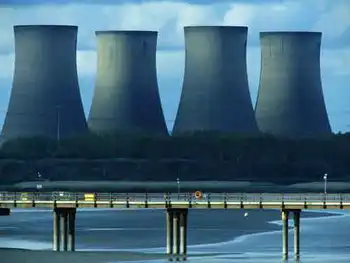Indian Point plant likely to survive ruling
NEW YORK STATE - Concerns for a primitive and endangered sturgeon and other denizens of the Hudson River have raised the prospect that the Indian Point nuclear plant, the biggest power producer in the New York metropolitan area, could be shut down.
But closing the plant would slash 18 to 38 percent of the energy available to a power-hungry region and deprive the plant's owner, Entergy Nuclear, of hundreds of millions of dollars in profits. That leads many experts to believe there are real-world solutions well short of a shutdown.
"I would think that in the end, there has to be some kind of a compromise because I don't see how you replace that kind of power," said environmental lawyer Charles S. Warren, a former regional administrator with the U.S. Environmental Protection Agency. "Recycling and windmills don't get you there."
At issue is the water Indian Point pulls in from the Hudson River_ as much as 2.5 billion gallons a day — to make steam and cool the two reactors, making it the largest industrial user of water in New York. Screens keep out most full-grown fish, but baby fish, fish eggs and other life forms are sucked in, tossed around, warmed up and sent back out, often dead or worse for wear. Some of the fish that hit the screens are also killed or injured.
The state Department of Environmental Conservation refused last month to grant a water quality permit that Entergy must have to renew its federal licenses and continue operating into the 2030s. The DEC found that the current "once-through" water system kills nearly a billion organisms a year, including the shortnose sturgeon, which is endangered in New York.
The DEC said it is illegal to kill any shortnose sturgeon, one of 140 species of fish in the Hudson River, including striped bass, American shad, the protected Atlantic sturgeon and river herring.
A 2008 study — disputed by Entergy — blamed power plants, in part, for a decline in 10 of 13 "signature" Hudson River fish species since the 1970s.
The DEC also found Indian Point in violation of the federal Clean Water Act, with leaks of radioactive tritium, strontium-90, nickel and cesium polluting the river.
The agency said Indian Point can operate legally only if it converts to a more environmentally friendly water-recycling system known as closed-cycle. That process was a condition of the plant's original licenses in the 1970s but has been stalled with various appeals and settlements.
Entergy contends building the necessary cooling towers would cost more than $1 billion, with a 10-month plant shutdown.
A full shutdown of Indian Point is exactly what many environmentalists and some politicians in the area have hoped for, especially since the 2001 terrorist attacks, when one of the hijacked jets flew over the plant on its way to the World Trade Center.
Critics contend that the plant's proximity to New York City — 35 miles from midtown Manhattan — makes it a tempting target that the densely populated suburbs around Indian Point could never be properly evacuated in an emergency and that recent problems with warning sirens and radioactive leaks betray carelessness.
Alex Matthiessen, president of the environmental group Riverkeeper, called for Indian Point's "early retirement" and said the DEC's ruling "put us closer to realizing a future without Indian Point."
After failing to get the plant closed over the evacuation issue in 2003, plant critics focused on re-licensing, which is well under way and involves studies by the Nuclear Regulatory Commission and public hearings. The NRC is in the midst of its own environmental study.
The NRC has never denied a license renewal for a U.S. nuclear power plant, but spokesman Neil Sheehan said the commission cannot issue new licenses without the state water permit.
Entergy Nuclear is appealing within the DEC and can go to court if it loses. If that delays federal re-licensing, the NRC could allow Indian Point to continue operating in the interim, Sheehan said.
If Indian Point doesn't get the new licenses and replacement power plants don't get built, New York might be in a bind. Indian Point produces about 2,000 megawatts of power, which is about 18 percent of what New York City and Westchester use at peak demand times. The percentage rises as high as 38 percent at other times.
"Without Indian Point, on the hottest August afternoon, you just hope you have enough backup power," said William Miller, professor of nuclear science at the University of Missouri in Columbia. "If there isn't enough, you start rolling brownouts and blackouts."
David Lochbaum, director of the nuclear safety project for the Union of Concerned Scientists, an environmental research and citizen action group, said there's already a bottleneck in transmitting power into New York, and "If Indian Point's not up, the bottleneck gets worse. Without that nearby source, more power produced elsewhere has to come in."
Riverkeeper's Matthiessen said the industry is trying to "scare the public into believing Indian Point power is indispensable: the lights would go off, subways would stop running and our hospitals would stop operating. None of that is true."
If the power grid would do better with Indian Point open, so would Entergy. A study for New York state legislators found that in 2009, Indian Point earned a pretax profit of $436 million.
"Plants like that are cash cows," said former NRC member Forrest Remick.
Closed-cycle cooling is neither new nor uncommon, but under various owners, Indian Point has successfully resisted it for 30 years. More than a third of the nation's 104 nuclear plants already use the technology, and it's required for all new large power plants — not just nuclear — in New York. On May 4, California regulators ordered coastal power plants to begin phasing out the "once-through" cooling process. In March, New Jersey ordered Exelon Corp. to retrofit its Oyster Creek nuclear plant with closed-cycle cooling. And in Ohio, activists are pushing for a cooling tower at a Lake Erie power plant, even as owner FirstEnergy Corp. installs gate-like devices to cut down on the fish kill.
Lochbaum said New York is on solid ground with its objections to Indian Point.
"It's not black and white, where one side is wrong and one is right," he said. "We'll see how the courts weigh those factors."
Courts might find it hard to ignore a 2009 Supreme Court ruling that the federal government can weigh costs against benefits in deciding whether to order power plants to undertake environmental upgrades that would protect fish.
New Yorkers should keep the bigger picture in mind, Lochbaum said.
"It would behoove us to remember that regardless of what happens now, at some point Indian Point isn't going to be there. Demand is only going to go up and we should plan for that."
Related News

Opinion: UK Natural Gas, Rising Prices and Electricity
LONDON - By Ronan Bolton
The year 2021 was a turbulent one for energy markets across Europe. Skyrocketing natural gas prices have created a sense of crisis and will lead to cost-of-living problems for many households, as wholesale costs feed through into retail prices for gas and electricity over the coming months.
This has created immediate challenges for governments, but it should also encourage us to rethink the fundamental design of our energy markets as we seek to transition to net zero.
This energy crisis was driven by a combination of factors: the relaxation of Covid-19 lockdowns across Europe created a surge in…




